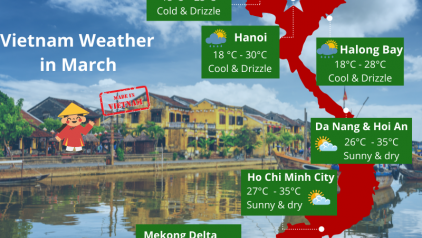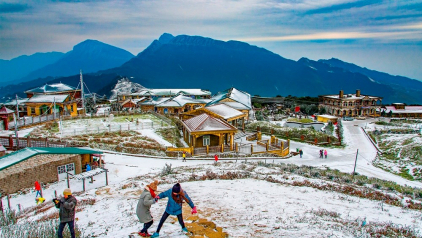Best Time to Visit Vietnam: All You Need to Know
Vietnam is a beautiful destination to visit all year round since there is no wrong time to plan a vacation in this lovely country. However, you should consider personal preferences and packing purposes to decide on the most suitable time to enjoy your trip to the fullest. The best time to travel to Vietnam depends greatly on different regions, seasonal climates, and festive occasions. Vietnam is best to visit all year round as tourists can enjoy the distinctive features of each season, region, and special event. Before planning a vacation, check this article out.
Vietnam has a charming S-shaped curve and a more-than-2000-mile coastline from the North to South, dividing Vietnam's climate into various types of weather on different geographic regions and seasonal climate throughout the year. Vietnam has a tropical climate influenced by the southwest monsoon from May to September and the northeast monsoon from October to April.
Generally, the best time of year to visit Vietnam is around March - April and October - December when the weather is comfortable and plenty of festivals occur in the whole country. In this article, you will get a glimpse of the featured climate by three main regions of Vietnam (the North, the Central, and the South) and special events to choose the best time to visit Vietnam.

Best time to visit Vietnam by weather and special events
Best time to visit Vietnam by weather
As mentioned above, Vietnam's weather is affected by the monsoon season with a considerable amount of sun, a high rate of rainfall, and high humidity. However, it is hard to choose the best weather as the three regions feature distinct conditions. Relying on altitude and latitude, temperatures in the South remain high all year round, while the North has a different seasonal climate. At the end of the year, it can be snowy in the northern mountainous whilst there is bright sunshine on the southern beaches. Following is a brief of Vietnam weather highlights in each region.
North: There are 4 seasons including spring (Feb – Apr), summer (May – Aug), fall (Sep – Nov), and winter (Dec – Jan). Particularly, it is hot and humid with high rainfall from May to October, while November to April is cooler and dry.
Central: The typical tropical monsoon climate brings hot temperatures almost over the year in the central region. The hot season occurs from January to August with average temperatures of mid-30s°C. The months from September to November receive the highest rainfall which results in heavy storms and floods.
South: There are only two seasons including the dry and wet seasons with remaining high temperatures all over the year. The dry season lasts from November to April and the wet season from May to October with the highest precipitation between June and August.
If you plan to visit the whole country, the best time to go to Vietnam is from March to April and October to November, when the country receives little rain in the dry season of the South and mild weather in the spring of the North & Central.
For more details, check this Vietnam weather overview out for detailed weather patterns and travel plans.
You should also avoid travel during the rainy season and typhoon season, let's learn some points about these seasons:
Visit in the wet season
Set location in the humid subtropical climate region, Vietnam monsoon season experiences from May to early November in most destinations, especially in the South. Throughout the wet season, there are frequent heavy showers and downpours in the mid-afternoon. The highest rainfall lasts from June to August, when the flood season starts in Hoi An Ancient Town, Ho Chi Minh City, and Mekong Delta during this time. Hanoi and the northern parts also receive heavy rains and occasional thunderstorms during the monsoon season.
Vietnam's wet season can be still an enjoyable time to travel if you know where to go and what to do on rainy days. It is highly recommended to visit Hanoi and the surroundings in the North during the monsoon season. And you should keep in mind that the wet season, especially October and November, is the cheapest time to go to Vietnam.
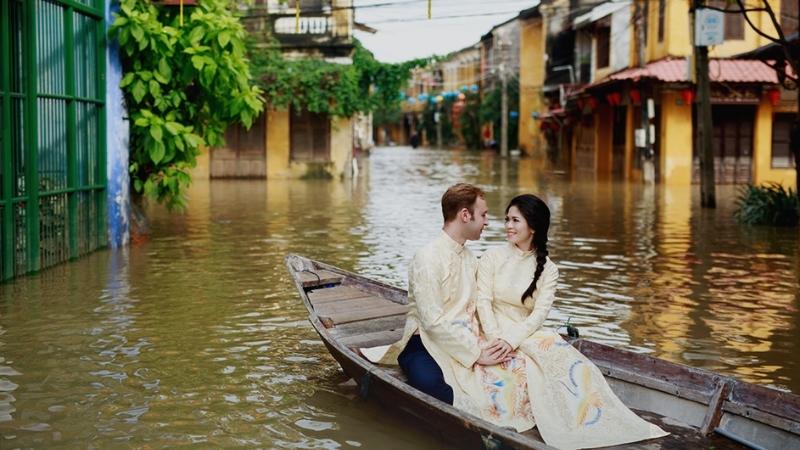
Couples still enjoy their romantic time to visit Hoi An during the flood season
Visit during the typhoon season
Another time to note before your Vietnam vacation is typhoon season which generally happens from August to December every year. All over the time, October tends to be the peak of the stormy season. It is expected to fierce weather events like tropical depressions and typhoons along with week-long downpours. Sometimes, they can cause devastating floods and landslides in some areas, especially the northern mountainous, and central regions. If you plan to visit Vietnam during the typhoon season, keep an eye on the weather forecast and skip the mountain as well as island destinations.
You may also like How to Deal with Halong Bay Cancellation Because of Bad Weather
Best season to visit Vietnam
Spring Season (Feb - Apr): Best time to enjoy flower blooming in Vietnam
Spring is considered Vietnam's best time to go with plenty of things to do and places to visit all around the country. The spring gets drizzles and warmer with average temperatures from 17 - 22°C in the North. Springtime must be the most favorite season as many tourists come to the North to enjoy the refreshing air as well as the festive season.
What to do during Vietnam spring:
- Go trekking/ hiking in the North and Central Highlands
- Catch sight of blooming seasons in the northern mountainous areas
- Celebrate Vietnamese Lunar New Year
- Book an overnight cruise in Halong Bay
- Explore magnificent caves in Phong Nha
- Soak up the sun on the southern and central coast beaches
February
February features the most optimal weather conditions, dry and rising temperatures, across the country. The North experiences cool days and little rains in the beginning of springtime, while the Central and South have clear skies and warm seawater. The average temperature in the North is 17°C, the Central is 25°C, and the South is 27°C.
What to expect in February:
- Vietnamese Tet Holiday: usually falls in early February then you can take consideration to visit the country during this period. It is a perfect time to learn about Vietnamese culture and traditional cuisine. However, please note that there is an upsurge in the service cost on the very first days of Lunar New Year.
- The blooming season of various types of flowers including cherry blossoms in Da Lat; plum, apricot, and peach blossoms in the northern mountains like Sapa, Ha Giang.
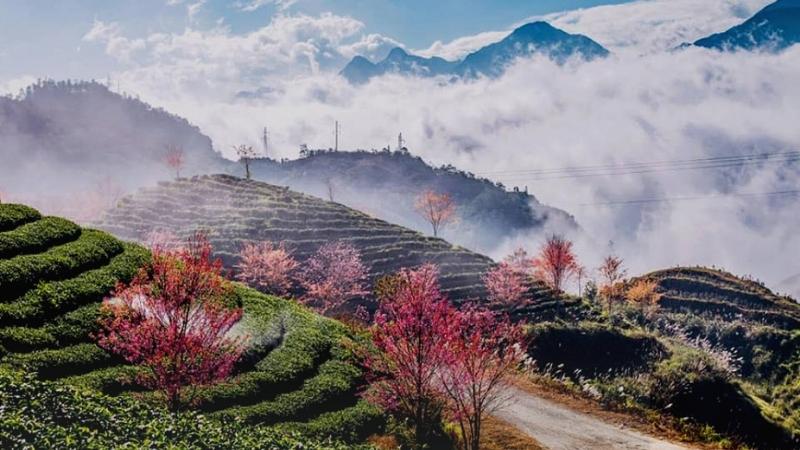
Visit Sapa for the captivating cherry blossoms sight
March
With regard to the weather, March must be the best month to visit Vietnam for a whole country itinerary. In the North, the temperatures tend to rise, making March an ideal time to go trekking to the highlands and take a Halong bay cruise. On the South and Central coast, you can enjoy sunshine days and mild weather on the beaches.
What to expect in March
- As the best time to go to Vietnam, March gives the driest and most moderate season to visit the South and Central coast cities like Hue – Da Nang – Hoi An.
- March is the season of white coffee flowers in the central highlands, Tay Nguyen and Da Lat. It is the most wonderful time to both enjoy the weather and admire the bloom season.
April
As the summer approaches, April is expected warmer temperatures and light rains in the North. The central coast and highlands have crystal skies and beautiful beaches. April is the end of the dry season; then you can see a low chance of rain in the South.
What to expect in Vietnam April: Making the best weather in Vietnam, April is a perfect time to visit islands (Halong Bay, Cat Ba Island, Ly Son, Phu Quoc), caves (Phong Nha), and beaches (Hoi An, Da Nang, Nha Trang).
Summer Season (May - Aug): Best time to enjoy Vietnam Beach Holiday
Summer is the best time to travel to Vietnam beaches as you can enjoy the seascape to the fullest. The summer with temperatures ranging from 25°C to 35°C is the rainy season in the North of Vietnam. It is quite hot but also the ideal time to see Vietnam under the blue sky, relax at crystal turquoise beaches and contemplate an awe-inspiring rainbow after a sudden shower in the afternoon.
What to do in summer
- Go for a trek in Cat Ba National Park during May
- Take a photograph at lavender hills at Sun World Fansipan Legend, Sapa
- Sunbathe at central coastline beaches in Lang Co, Non-Nuoc, Cua Dai Beach, etc.
- Explore the caves in Phong Nha and Halong Bay
- Go sand sliding in Mui Ne
- Sit back on the sandy beaches of Nha Trang and Phu Quoc
- Take a stroll around the ancient town of Hoi An
May
May is a sign of the new season, summer in the North, and monsoon season in the Central and South. You can hardly feel the heat and frequent rain in early May. The North is still dry and vibrant with a maximum temperature of 30°C. The Central has the best climate in May; meanwhile, the South is getting hot with short afternoon downpours.
What to expect:
- As the butterfly season in Ninh Binh, May is the best time to trek at Cuc Phuong National Park to catch this stunning sight and discover the ecosystem in Vietnam.
- The mountainous areas in northern Vietnam come to changing seasons of rice terraces. You can see the paddy fields turning into mirroring patches filled with water for the preparation of the next crop.
June
Vietnam experiences higher temperatures and more frequent thunderstorms in June. However, the bright blue sky on sunny days is perfect for photography. In the northern, it is hitting up to reach mid-30s°C on average; in the central, it is still expected decent weather; in the southern and central highlands, floods are increasingly common.
What to expect:
- Tropical beaches and coastline cities are the best destination to visit in June. It is a good time to visit Halong Bay, Da Nang, Nha Trang, Con Dao, etc. to enjoy pristine beaches. Particularly, June is the month of the turtle hatching season in Con Dao Island.
- Late June is the best time to visit Da Nang and contemplate the International Firework Competition with the most captivating firework show ever.
- Sapa becomes more appealing in blooming lavender season at Sun World Fansipan Legend.

Spend your summer on Vietnam's tropical beaches
July
Like June weather, downpours can happen at both ends of the country, with strong winds and thunderstorms. In southern, the monsoon season also hits its peak with daily downpours. The overheat temperatures can peak at 40°C and cool down until midnight. However, the pretty clear sky and bright sunshine are perfect to enjoy beach relaxation across the country.
What to expect: The central region between Da Nang and Nha Trang is the best place to enjoy seascape in July. Despite the heat and infrequency of the rain, Vietnam weather in July is perfect for outdoor water activities on the central coastline.
August
Known as the peak rainy month in northern and central, heavy storms occur frequently. August temperatures are not as high as June and July averages, from 27 - 32°C in Hanoi and lower in Da Nang and Ho Chi Minh City. It also marks the beginnings of typhoon season in the North and flooding season in the Mekong Delta.
What to expect:
- August is still a good time to travel to Vietnam with a variety of rain-free hours in the day. On the whole, the central coast like Nha Trang is still amazing to spend a couple of days relaxing.
- Due to the peak of the wet season, August is considered one of the cheapest months to go to Vietnam. If you aren’t afraid of the floods and the high chance of Halong cruise tour cancellation, travel to Vietnam in August will give you unique experiences.
Autumn Season (Sep - Nov): Romantic time to visit Vietnam
Autumn is the best season to visit Vietnam, so there is an abundance of gorgeous attractions and interesting activities to uncover. Autumn will give you a special time to see a romantic Hanoi with yellow leaves falling everywhere on the streets. In autumn, the weather gets cool and breezing when daytime temperatures range from 15 - 28°C and night-time temperatures from 10 - 18°C. The rainfall peaks during the months between July and Sep.
What to do in autumn
- Go hiking/ trekking to hill tribe villages in Sapa
- Feast your eye on golden rice terraces in Mu Cang Chai
- Hunt the clouds in northern mountainous areas (Yen Bai, Lao Cai, Ha Giang, etc.)
- Catch the best sight of buckwheat flowers in Ha Giang and wild sunflowers in Da Lat
- Take a Halong Bay cruise tour in 2 or 3 days
- Wander around the streets of Hanoi Old Quarter to soak up the refreshing air and taste Vietnamese traditional dishes
- Visit the Imperial City of Hue or explore the off-the-beaten-path in Bach Ma National Park
- Experience Vietnam’s floating markets in the Mekong Delta
- Hit up wonderful beaches in the South
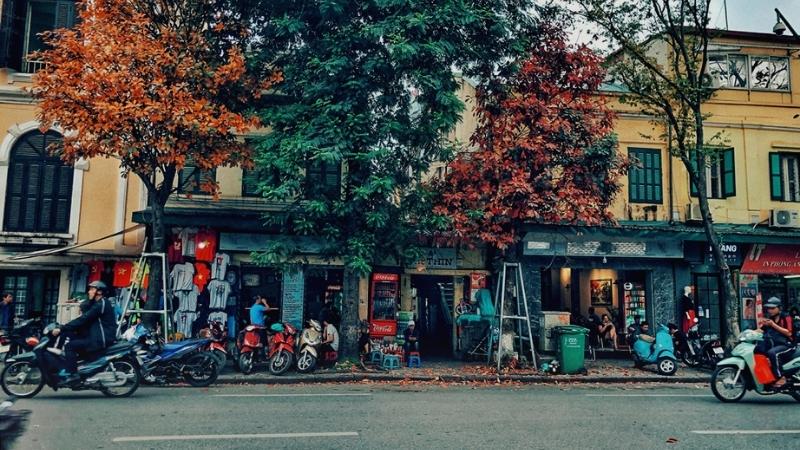
Autumn is the best time to visit Hanoi, Vietnam
September
As the start of autumn, September is one of the best months to visit Vietnam, when the temperature and rainfall drop considerably in the North. In the south and central highlands, the rainy season still happens to cause flooding season in some main destinations like Hoi An, Phong Nha – Ke Bang, Ho Chi Minh City, and Mekong Delta.
What to expect
- September is the best time to visit Hanoi thanks to the romantic atmosphere of the cool breeze along with seasons of milk flower and green rice.
- It is highly expected to harvest season in northern mountainous areas. Sapa and Mu Cang Chai are the highlights to catch the sight of golden rice terraces in September.
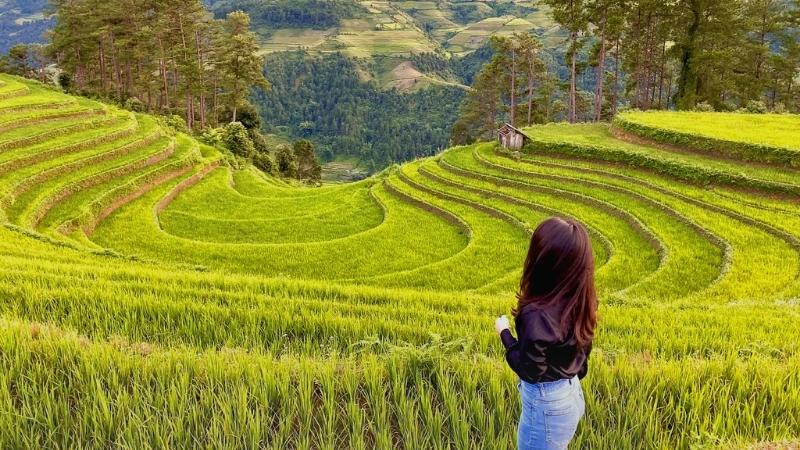
September is the best time to see golden rice terraces in Vietnam
October
October is the official sign of autumn in northern when the temperatures fall a little bit further, the rainfall is lesser, and the air gets chillier. The central regions receive less sunshine and more rainfall, resulting in severe flooding in Hoi An Ancient Town. Meanwhile, the southern areas are drier and warmer.
What to expect
- As the best time to visit North Vietnam, October is a great month for trekking in Sapa and other northern provinces.
- October is another blooming season in Vietnam to admire the charm of buckwheat flowers in Ha Giang and wild sunflowers in Da Lat.
- It is also the best time of year to behold the beauty of Ba Be Lake (Bac Kan Province) and Ban Gioc Waterfall (Cao Bang Province).
November
November is another best time of year to visit Vietnam, from the northern loop to the southern tip of the country. During November, the North remains a pleasant climate of late autumn; the temperatures drop further down to an average of 24°C; the humidity also decreases, and the air is clearer. The Central is at the end of the rainy season due to the northeasterly winter monsoon. Meanwhile, the South experiences balmy days after the monsoon season.
What to expect November
- Northern mountains in Vietnam are most stunning in November, with a cloud hunting trip, a trekking tour, or buckwheat flower sightseeing.
- November is also a perfect time to take an overnight cruise in Halong Bay and go trekking in Cat Ba National Park.
- The floating market in Mekong Delta gets more dynamic in November.
Winter Season (Dec - Jan): Best weather to visit Vietnam
If you want to hide away from the cold in the North, winter is a fantastic time to head for the South of Vietnam. In winter, the weather becomes cold and dry; the temperature is lowest with average temperatures of 15 - 20°C. In some mountainous area as Sapa, Tam Dao, Hoang Lien Son, etc., it can be down to 0°C and starts to snow. If you are into warm feelings in layering clothes, winter is the ideal time to visit northern Vietnam. Also, chilly wintertime is best for trekking and vietnam cycling tours in the North area.
What to do during winter
- Experience the extreme cold in the northern mountains as well as snowfall only in Sapa
- Taste appetizing local dishes amid Hanoi winter
- Join water activities on the southern coast, particularly Mui Ne and Phu Quoc Island
- Learn about Vietnamese traditions and customs on the occasion of the Tet Holiday

Trekking is best in wintertime in Northern Vietnam
December
December is one of the driest months in Vietnam, making the least rain in most parts of the country. In the North, the beginning of winter brings balmy temperatures of 20°C on average, occasional drizzles, and chilly breezes. In central Vietnam, the end of the rainy season offers average temperatures of 24°C and the landscapes become more stunning in their original beauties. In the South, it is consistently sunny with temperatures averaging at 26°C.
What to expect:
- December marks the best time to visit Ho Chi Minh City and southern beaches like Mui Ne, Phu Quoc, etc. to get away from the coldness in the North.
- It is best to get some chilly in the northern mountains. If the cold doesn’t bother you, go experience the rare snowfall in Sapa and the surroundings.
- Christmas and New Year Eve could be amazing in large cities like Hanoi and Ho Chi Minh.
January
January is one of the coldest months but the best months of the high season in Vietnam. In some northern provinces, you will find the extremely cold winter (average temperatures of 15°C) with frequent drizzles, persistent mists, frozen, and rare snowfall. In the central and south, it is at peak of the dry season with average temperatures of around 25 - 30°C.
What to expect in January:
- Late January is usually the last month of the Vietnamese lunar year, making the atmosphere bustling and festive. It is the best time to visit Vietnam for deeply cultural insights.
- The warmth in southern and central creates favorable conditions to enjoy water activities like swimming, snorkeling, diving, water skiing, and more.
Best time to go to Vietnam by region
Due to the differences in latitude and topography, Vietnam is divided into 3 main regions corresponding with 3 separate weather systems. That is the reason why the best time to visit Vietnam can vary from region to region.
Best time to visit Northern Vietnam
The best time to visit Northern Vietnam range from October to next April. Despite the cold in December and January, you can enjoy the most beautiful Vietnam in the dry season and vibrant festival season.
There are four distinct seasons in the north: summer (May – Aug), autumn (Sep – Nov), winter (Dec – Jan), and spring (Feb – Apr). As far as we are concerned, the climate is various and witnesses the most considerable changes in northern Vietnam.
- Hanoi capital has the calmest weather conditions then best visited all year round. Summer temperatures can peak at 39°C and winter temperatures can down to 9°C with extreme cold from the northeast monsoon. Generally, Hanoi is hardly expected severe floods, earthquakes, typhoons, and other natural disasters. September to November is the best time to visit Hanoi and fully experience the most beautiful season of the year.
- Halong Bay landscape is awe-inspiring to take a cruise tour throughout the year, except the typhoon season from July to August.
- Ha Giang and Sapa set location in far northeast mountainous regions where the winter cold can be frozen and snowed in late December and January. The most suitable time to travel to the Vietnamese northern mountain is the dry months, from September to April. Not to mention, Sapa in September and Ha Giang in November are most beautiful with golden rice terraces and buckwheat flower blossoms.
| Top recommend North Vietnam tours: |
Best time to visit Central Vietnam
An interesting fact is that the weather in Central Vietnam is kind of a transitional area climate-wise from the North to the South. There is a difference between the climate in North-Central (Hai Van Pass’s North) and South-Central (Hai Van Pass’s South). The most typical climate feature of Central Vietnam is that the rainy season and dry season don’t happen at the same time as the rest climate (the North and the South).
In Hoi An, Hue, and Da Nang, the hottest time and dry climate occur from mid-Jan to August. During this time, the average temperature is around 30°C and sometimes can peak at 40°C. The rainy season starts from August to December with the highest precipitation as well as a high chance of floods between Oct and Nov. If you intend to visit Hoi An, Hue, and Da Nang, remember to avoid this typhoon season.

February to May is the best time to visit Central Vietnam
In the central highland, Da Lat experiences wet weather from June to October and dry, cold seasons in December and January.
Further south of Central Vietnam, coastal provinces from Nha Trang to Mui Ne features a longer dry season, which is typically from January to September. In contrast, the summertime in the South-Central region has higher temperatures. As being less affected by the rain, the rainy season runs only from October to early December.
All things considered, you should avoid visiting Central Vietnam during the rainy season (August to December) unless you want to experience heavy storms as well as floods. It is highly recommended to book a tour to Central Vietnam from February to May.
| Top recommend Center Vietnam tours: |
Best time to travel to South Vietnam
The South of Vietnam is typical of a humid tropical climate which remains constant temperatures from 25 to 35°C all year round. There are two main seasons: the rainy and the dry season. The dry season lasts from November to the end of April when it is hotter and more humid from late February to April.
The rainy season runs from June to November with the highest rainfall occurring from June to August. During the rainy time, you will most likely see sudden and heavy downpour rain in mid-afternoon in Ho Chi Minh City. Also, there is frequent flooding in the months between July and August. Despite the wet climate, the rainy season is a good time of the year to visit Southern Vietnam if you don’t mind experiencing a few raindrops.
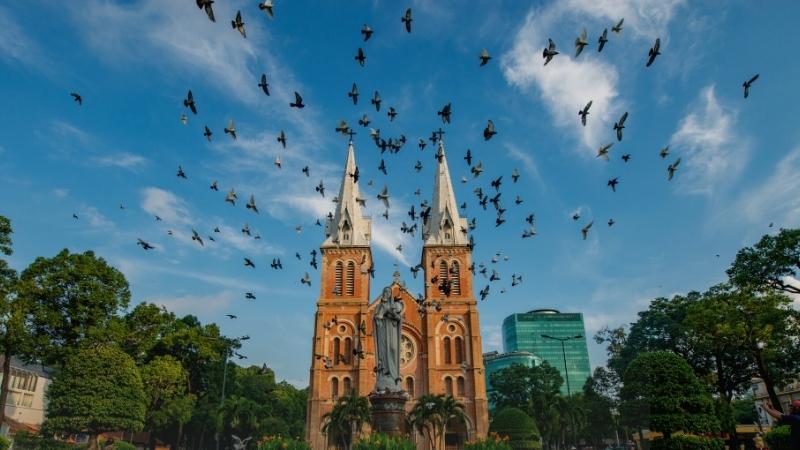
December to April is the best time to travel to Southern Vietnam
The Mekong Delta becomes more attractive and lively when the dry season comes. Though the best time to enjoy vibrant floating markets is the dry season, Mekong Delta in monsoon season is surprisingly gorgeous for photography as dramatic thunderheads float across and rice paddies are covered in vibrant emerald green.
To sum up, the best time to visit Southern Vietnam is in the dry season, especially the months from December to April. If you are fed up with the cold weather, Southern Vietnam is a perfect place to take a break from it.
| Top recommend South Vietnam tours: |
Best festivals season to visit Vietnam
Apart from Vietnam weather, key Vietnamese events and festivals also play a vital role in choosing the best time to visit Vietnam. As a multicultural country, Vietnam has many traditional festivals to learn about the traditions and customs in the country. Let's take a look at these annual festivals then set the most suitable time to go to Vietnam.
Tet Holiday: The most important national holiday in Vietnam is the Lunar New Year, also known as Tet Holiday. The holiday lasts for 7 days, usually happening between the last week of January and the second week of February. During this time, the cost of transportation and accommodation rises 2 - 3 times. Also, the holiday surcharge is relatively high due to the overtime pay for staff members. Most businesses close for a few days on the Vietnamese Tet Holiday, so those who work during Tet will get 300% more of a one-day salary according to the labor law of the government.
If you are going to visit Vietnam from late January to early February, please check the Vietnamese lunar calendar out to avoid the time of the Tet holiday. Instead of visiting Vietnam between January and February, you can book after that time (March - April), when the spring comes up with many exciting spring festivals and nice weather.
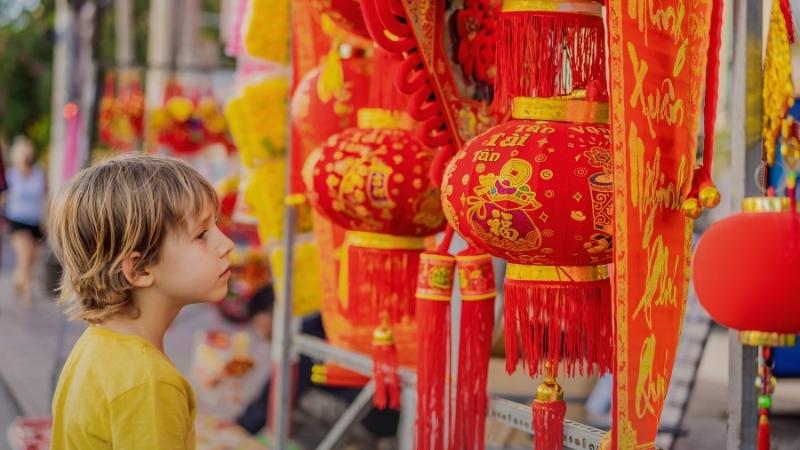
One of the most iconic traditions of the Tet Holiday in Vietnam
International Labor Day: The 1st of May coincides with the Reunification Day on April 30th in Vietnam. The Vietnamese may spend a couple of days traveling across the country. If you choose this time to visit Vietnam, you will see the crowds of domestic travelers and a small surcharge on a national holiday.
Hue Festival: The 6-day festival of a spectacular range of shows, performances, art exhibits, and cultural activities is taken place from April to May every two years. Coming to Hue during this time, you can behold the Ao Dai fashion show, which echoes from Perfume River, Hue Citadel, as well as Hue Royal's inspiration and international art. Da Nang
International Fireworks Festival: Celebrated in June annually, the International Fireworks Festival presents an impressive performance of fireworks displays in creatively different themes. With the participation of both local and international teams, the festival attracts a large number of tourists to admire the dazzling sky along the side of the Han River.
Vietnamese Independence Day: On September 2nd, you will see the country brightened up with national flags and remarkable events to celebrate the Independence Day of Vietnam. It is recommended to visit the Hanoi capital during this time to get a deep insight into Vietnamese history and tradition.
Mid-Autumn Festival: Based on the lunar calendar in Vietnam, Mid-Autumn Festival usually falls between September and October. Hanoi and Hoi An are two must-visit destinations to enjoy the excitement and beauty of lanterns at night.
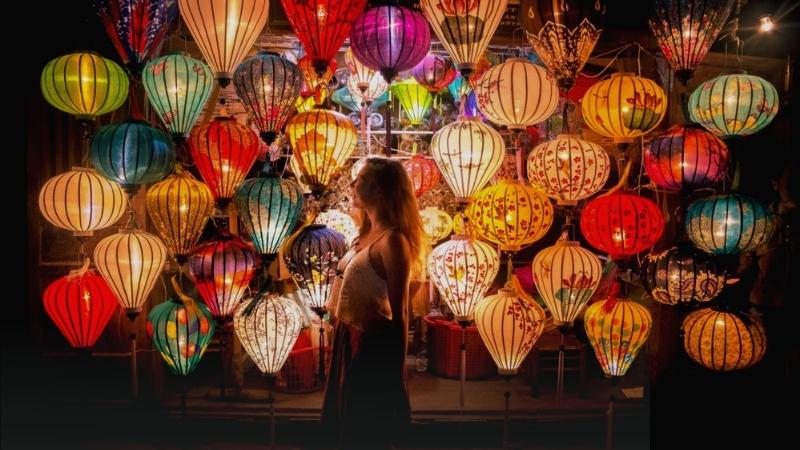
Hoi An is best visited at Mid-Autumn Festival
In conclusion, it is hard to point out exactly when the best time to visit Vietnam is. As a truth, travel to any part of Vietnam during any season is possible. You can visit Vietnam at any time of year thanks to the diverse terrain in each region. There is no perfect time to visit Vietnam as a different climate between Northern, Southern, and Central.
If you desire to visit the whole country, it is a good idea to travel to Vietnam from November to April, the dry season, and also the peak season of Vietnam tourism. You can have the most flexible itinerary and activities thanks to the best weather all around. In particular, plan your trip to see Hanoi, Halong Bay, and Sapa from September to December. Enjoy little rain and clear skies in Saigon and Mekong Delta between December and March. Meanwhile, the central coast from Hoi An, Hue down to Nha Trang is great to visit in the first half of the year, between January and June.
| In case you still have no idea to plan a trip, let's see our Vietnam tours list and find the best option or contact our travel consultant for more support. |
You may also like Tips for first-time travelers to Vietnam
Nhung Dang
(Images source: Internet)
